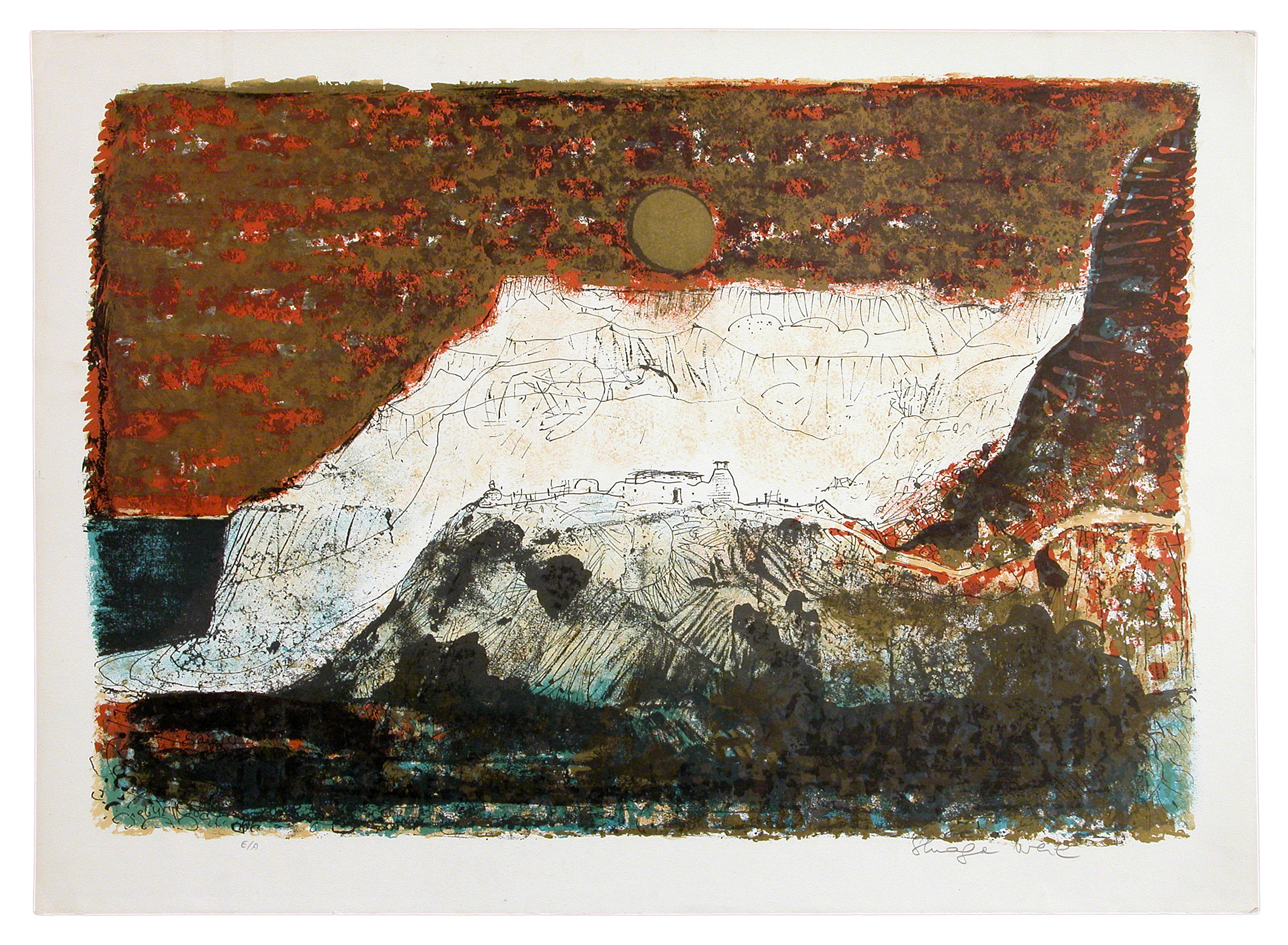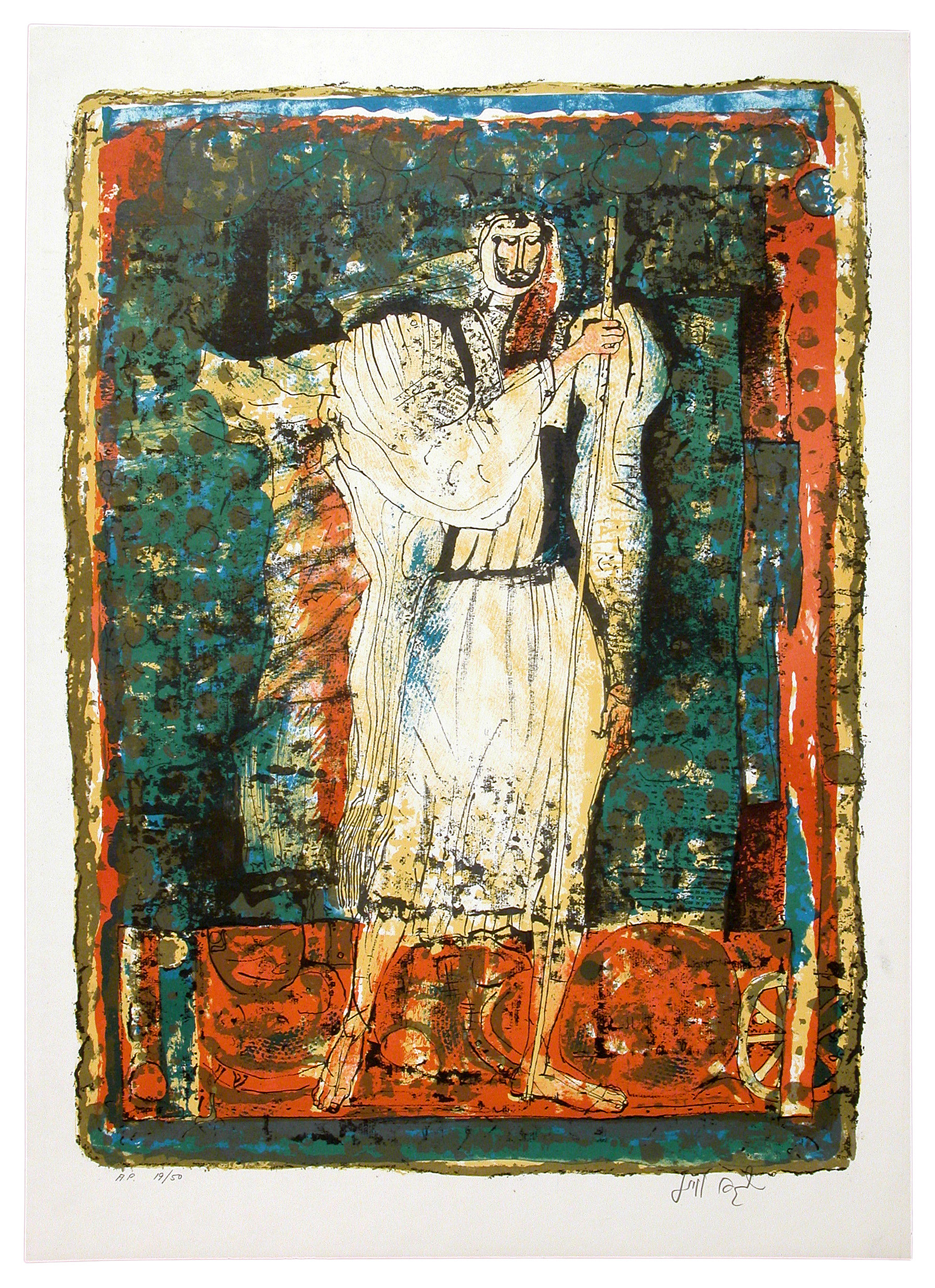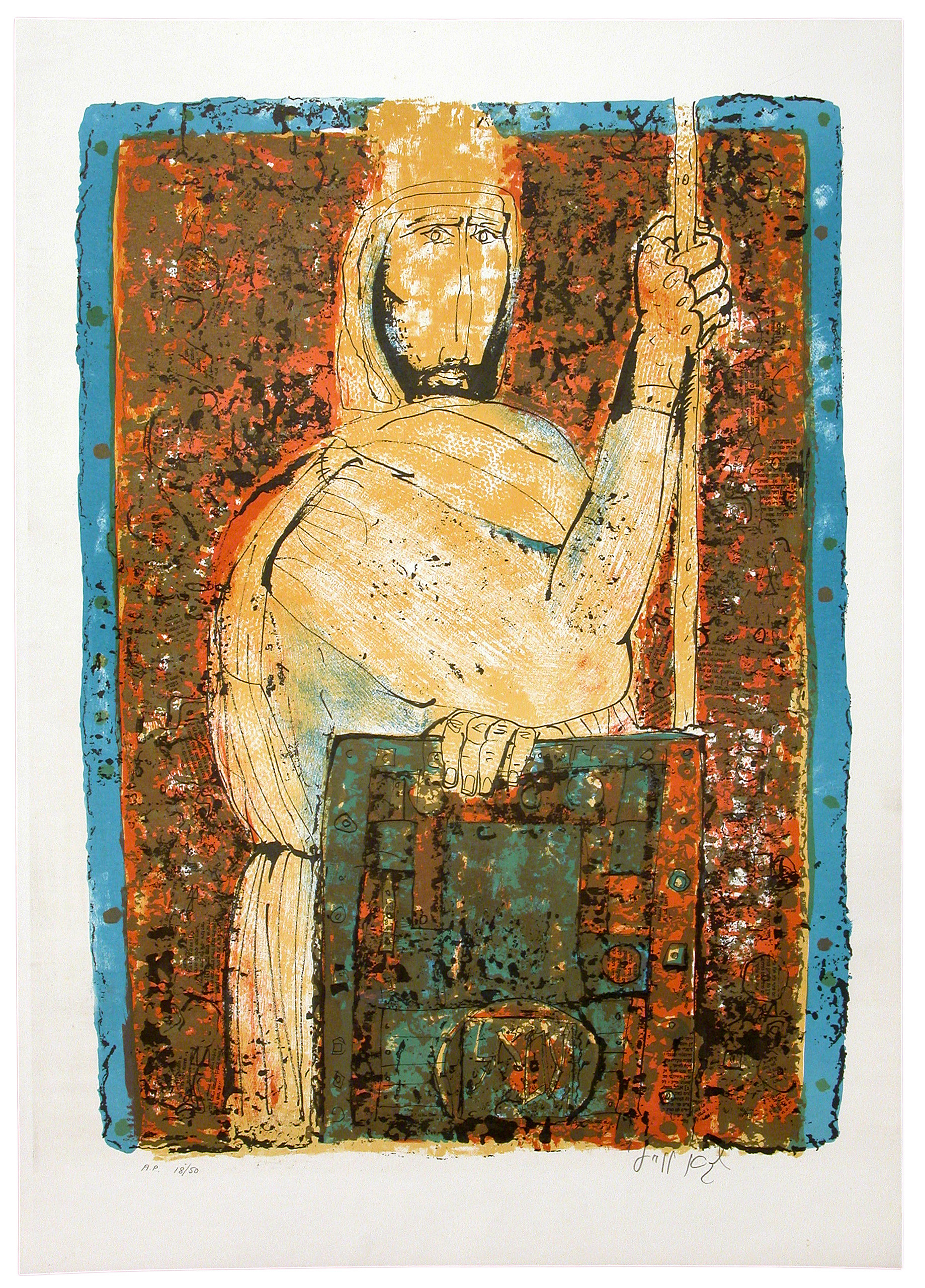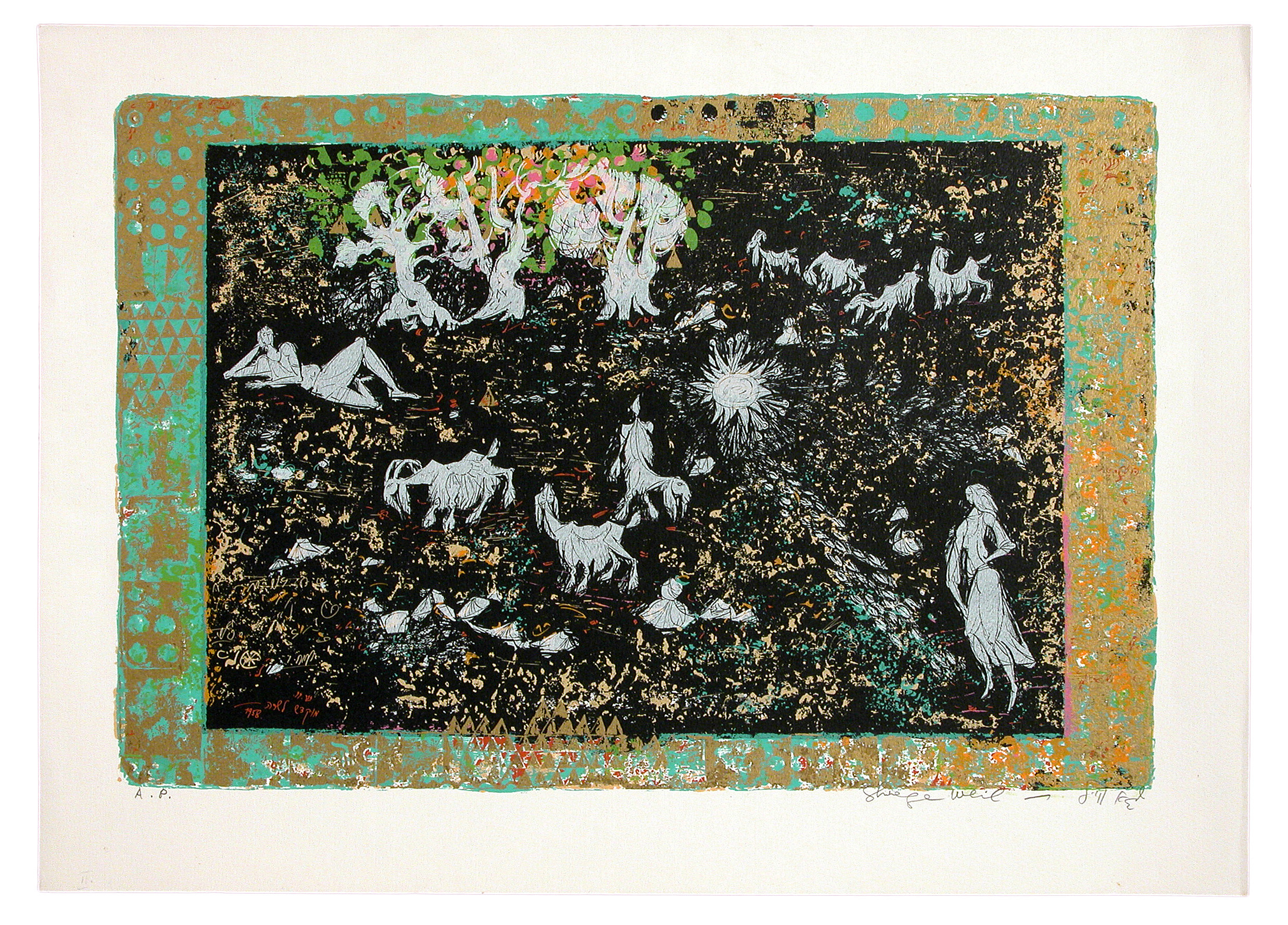Weil Shraga

Weil Shraga
S-11 Caves of Qumran
$500
27.5 inches wide x 19.75 inches high 70 cm wide x 50 cm high Serigraph 1965 Edition 150
Shipping & Handling: $30
In 1947, ancient manuscripts were discovered at Khirbet Qumran (near the Dead Sea). Scholarly disputation has continued since their discovery about the nature of the community which created these valuable documents. The structure of the community was outlined in one of the Scrolls entitled The Manual of Discipline: “The members were all Jewish and regarded themselves as the true Israel; they understood the history of Israel and the promises to the patriarchs as being fulfilled in them, the actually existing community.”
Shraga Weil was born in Nitra, Czechoslovakia in 1918 to a family of teachers, journalists and merchants. His father, a building engineer, who was an amateur painter, sent him to study with a local sculptor and then to the Prague School of Art.
He produced his first graphic works during World War II, part of which he spent as a prisoner. After the war, Weil sailed for Israel on an illegal immigrant ship, eventually arriving in the new country in 1947 and becoming a member of Kibbutz Haogen, where he has been living ever since.
In 1954 Weil spent some time studying murals and graphic techniques at the Academie des Beaux Arts, Paris and Ravenna mosaics with Prof. Severinl.
Shraga Weil’s works have been exhibited in the United States, South America, Canada, Australia, France, the USSR, Switzerland, and in the International Exhibition of Graphic Arts, in Lugano. In 1959, Weil was awarded Tel Aviv’s Dizengoff Art Prize

Weil Shraga
S-12 Shepherd of Qumran
$850
19.75 Inches wide x 27.5 Inches high 50 cm wide x 70 cm high Serigraph 1965 Edition 150
Shipping & Handling: $30
In 1947, ancient manuscripts were discovered at Khirbet Qumran (near the Dead Sea). Scholarly disputation has continued since their discovery about the nature of the community which created these valuable documents. The structure of the community was outlined in one of the Scrolls entitled The Manual of Discipline: “The members were all Jewish and regarded themselves as the true Israel; they understood the history of Israel and the promises to the patriarchs as being fulfilled in them, the actually existing community.”
Shraga Weil was born in Nitra, Czechoslovakia in 1918 to a family of teachers, journalists and merchants. His father, a building engineer, who was an amateur painter, sent him to study with a local sculptor and then to the Prague School of Art.
He produced his first graphic works during World War II, part of which he spent as a prisoner. After the war, Weil sailed for Israel on an illegal immigrant ship, eventually arriving in the new country in 1947 and becoming a member of Kibbutz Haogen, where he has been living ever since.
In 1954 Weil spent some time studying murals and graphic techniques at the Academie des Beaux Arts, Paris and Ravenna mosaics with Prof. Severinl.
Shraga Weil’s works have been exhibited in the United States, South America, Canada, Australia, France, the USSR, Switzerland, and in the International Exhibition of Graphic Arts, in Lugano. In 1959, Weil was awarded Tel Aviv’s Dizengoff Art Prize.

Weil Shraga
S-13 Guardian of Qumran
$850
19.75 Inches wide x 27.5 Inches high 50 cm wide x 70 cm high Serigraph 1965 Edition 150
Shipping & Handling: $30
In 1947, ancient manuscripts were discovered at Khirbet Qumran (near the Dead Sea). Scholarly disputation has continued since their discovery about the nature of the community which created these valuable documents. The structure of the community was outlined in one of the Scrolls entitled The Manual of Discipline: “The members were all Jewish and regarded themselves as the true Israel; they understood the history of Israel and the promises to the patriarchs as being fulfilled in them, the actually existing community.”
Shraga Weil was born in Nitra, Czechoslovakia in 1918 to a family of teachers, journalists and merchants. His father, a building engineer, who was an amateur painter, sent him to study with a local sculptor and then to the Prague School of Art.
He produced his first graphic works during World War II, part of which he spent as a prisoner. After the war, Weil sailed for Israel on an illegal immigrant ship, eventually arriving in the new country in 1947 and becoming a member of Kibbutz Haogen, where he has been living ever since.
In 1954 Weil spent some time studying murals and graphic techniques at the Academie des Beaux Arts, Paris and Ravenna mosaics with Prof. Severinl.
Shraga Weil’s works have been exhibited in the United States, South America, Canada, Australia, France, the USSR, Switzerland, and in the International Exhibition of Graphic Arts, in Lugano. In 1959, Weil was awarded Tel Aviv’s Dizengoff Art Prize.

Weil Shraga
S-14 Song of Songs ( Dark)
$400
27.5 Inches wide By 19.5 Inches high 70 cm wide By 50 cm high Serigraph 1967 Edition 150
Shipping & Handling: $30
“If thou know not, o thou fairest among women, go thy way forth by the footsteps of the flocks, and feed thy kids beside the shepherds’ tents.” This is the shepherd’s response to his love’s question: “Tell me, o thou whom my soul loveth, where thou feedest, where thou makest thy flock to rest at noon.”
Shraga Weil was born in Nitra, Czechoslovakia in 1918 to a family of teachers, journalists and merchants. His father, a building engineer, who was an amateur painter, sent him to study with a local sculptor and then to the Prague School of Art.
He produced his first graphic works during World War II, part of which he spent as a prisoner. After the war, Weil sailed for Israel on an illegal immigrant ship, eventually arriving in the new country in 1947 and becoming a member of Kibbutz Haogen, where he has been living ever since.
In 1954 Weil spent some time studying murals and graphic techniques at the Academie des Beaux Arts, Paris and Ravenna mosaics with Prof. Severinl.
Shraga Weil’s works have been exhibited in the United States, South America, Canada, Australia, France, the USSR, Switzerland, and in the International Exhibition of Graphic Arts, in Lugano. In 1959, Weil was awarded Tel Aviv’s Dizengoff Art Prize.
Museums and Public Collections
Brandeis University, Waltham, Massachusetts
Boston Public Library
Israel Museum, Jerusalem
William Rockhill Nelson Gallery, Kansas City, MO
Fogg Museum, Harvard University
Los Angeles County Museum
Jewish Museum, New York
Philadephia Museum of Art
Joslyn Museum, Omaha, Nebraska
Judah Magnes Museum, Berkeley, CA